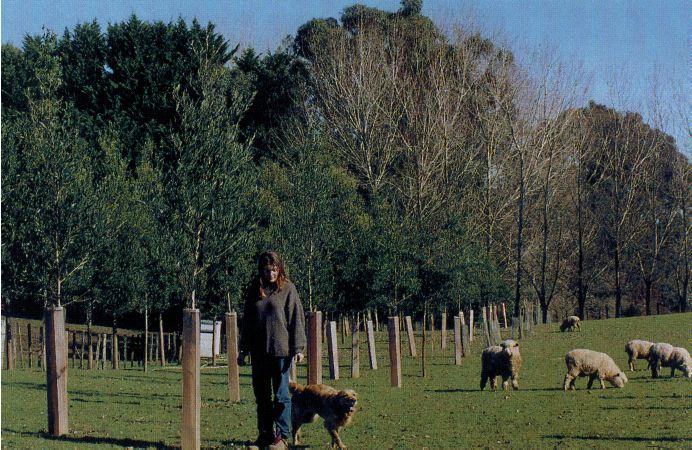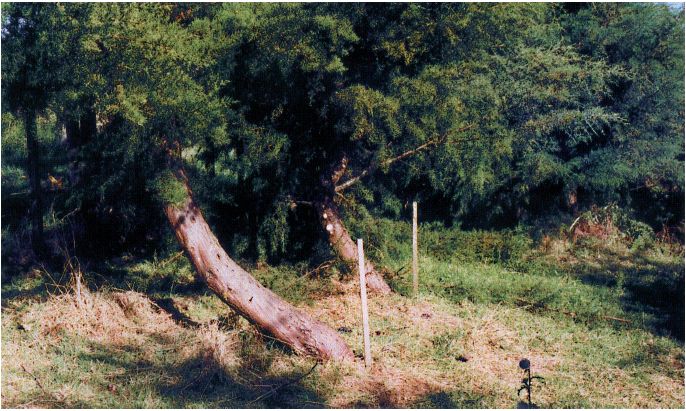Tree shelters - how good are they?
NZFFA Information leaflet No. 5 (2005).
Setting the scene<
In recent years tree shelters have become part of the new landscape of Britain. They have polarised opinion. Their supporters regard them as the greatest contribution to forestry since the chainsaw; on the other hand their detractors view them with distaste, as components of ‘graveyards’ which disfigure the countryside.
Over 10 million are manufactured each year in the UK for use mainly in hardwood plantations. Their attraction lies in improved tree establishment on inhospitable sites, protection from wildlife and enhanced growth rates.
Research in New Zealand has been limited, and suggests that we cannot directly apply British experience. Tree shelters have had a mixed press in Australia, where special problems include rapid disintegration and over heating.
I have used tree shelters for 6 years across a range of species. It is clear that in our climate growth responses to shelter differ from the UK. There is also much variation between species. I will illustrate this by describing a personal experience of tree shelters with two species in which growth behaviour has shown wide differences: Cupressus lusitanica and Acacia melanoxylon. 600mm KBC® shelters were used initially for protection against hares, and on another site 1200mm shelters were used to allow grazing by sheep.
Height growth
Tree shelters produce a greenhouse effect, resulting from an increase in temperature and humidity, elevated CO2 and protection from wind. This enhances photosynthesis and improves water relations, and the outcome is a true improvement in growth performance. British reports emphasise an increase in early height growth in most species. It is not easy to discern any pattern, although the effect is greater in slow growing species, and in hardwoods rather than conifers.
Blackwoods: Using 600mm shelters we have measured a 25% height increase in the first summer compared with control trees. After 2 years the difference fell to 10%. The response was greater in 1200mm shelters.
Lusitanica: There was no significant height increase in 600mm shelters compared with controls.
In some species the early growth response to tree shelters is dramatic and has attracted much attention. However, the height advantage diminishes over time, and is unlikely to offer a significant benefit in reducing crop rotation. There may however be other advantages in increased early growth:
- It may allow the earlier introduction of livestock.
- Where stability is not a problem, the shelters can be re-used.
- A possible influence of accelerated growth on tree form.
Form
The promoters of tree shelters refer to an improvement in form and reduced taper and branching inside the shelters. This seems a very modest claim: foresters who have a problem controlling form in the bottom metre should be growing gooseberries, not trees.

The influence on form of trees when they emerge from their shelter has attracted less interest. British reports suggest that they resume their normal growth habit, but lack detail. Certainly the shelter rim is a zone of sudden climatic transition, and some growth effects might be expected above it.
Deciduous species form large dormant buds within the shelter, and this will produce vigorous extension growth in the emerging shoot. However, there are reports that the sudden exposure of protected foliage to a harsher climate can result in shoot tip damage.
In deciduous species which have sustained rather than fixed growth, shelters have been shown to extend the period of summer growth. This can result in impressive growth extension, but might might impose another risk by predisposing the terminal bud to damage in subsequent winter frosts. This is a known risk where sustained growth is encouraged by high nitrogen fertility, or inappropriate provenance selection, and can result in malformation in the following spring.
Blackwoods: Shoot growth in this species is indeterminate: periods of shoot extension are terminated by abortion of the shoot tip. Malformation occurs as the leader is replaced. In theory, tree shelters might be expected to reduce this effect for the following reasons:
- In species which have indeterminate growth, vigorous growth is associated with a reduction in shoot tip abortion.
- Conditions within the tree shelters appear to delay the conversion from juvenile to adult growth phase in blackwood. Juvenile growth favours stem extension at the expense of branching, and has a reduced frequency of shoot tip abortion. To test this we have examined malformation by measuring the location of collar scars (a result of leader replacement) in a 1 metre segment of stem above 600mm shelters, and compared this with a similar segment of stem in adjacent control trees. Shelters were associated with a 40% reduction in collar scars. The effect is greater in 1200mm shelters. It appears therefore that in blackwood, conditions within the shelter will reduce malformation above it.
Lusitanica: This species has strong apical dominance and was not influenced by the shelters.
In summary, tree shelters are likely to influence tree form above them in different ways, depending on species, site factors and shoot characteristics. However, when the aim is to produce a 5 to 6m butt log they will not replace the need for silvicultural methods such as form pruning or competitive growth systems.
Stability

Tree shelters encourage extension growth at the expense of stem diameter and root development. In some species this can result in instability, and UK reports advise that they should be retained for 5 years. In New Zealand, with more fertile conditions and stronger winds the risk of instability might be expected to be greater.
Blackwood: Instability was not a significant problem. In 600mm shelters the shoots emerge early in the first summer. On exposed areas the leading shoot sometimes bends, but usually realigns, and if not, a lateral shoot can be trained to replace it. In 1200mm shelters the effect was greater, but could be controlled. We were able to remove the 600mm shelters after the first summer, and re-use them, without loss of stability.
Lusitanica: In contrast, instability was a major problem and occurred in three stages:
- In the first summer the stems were very spindly, and if the shelters were removed the trees fell over. Weakness extended throughout the stem length, and presumably resulted from shielding from severe stress. We promptly replaced the shelters.
- In the second summer vigorous growth occurred above the shelters, presenting a sail area to the wind, and they broke out of the shelters. On this occasion the point of weakness was at the root/stem junction. Undeterred, they resumed growth, leaving a row of trees with a 90° butt sweep. An adjacent row of open grown trees remained stable.
- A few of the sheltered trees had remained straight. In the fourth summer several of these blew over in a wind gust, in spite of a recent stability prune. Examination showed defective root development. This suggests to me a possible long term deficiency in strength or orientation in root development in some species which are denied wind exposure in their first year.
Protection
Establishment: A major role for tree shelters in the UK is to encourage tree survival on sites exposed to wind and frost. They also reduce water loss by allowing condensation, and by reducing leaf vapour pressure difference. There is in addition a ‘trickle irrigation’ effect where water from light summer rains is directed by the shelter to the root area, which may be helpful in the first summer. High temperatures within the shelters have not caused problems within the UK or New Zealand, but may do so in Australia.
Weed control: Shelters allow easy tree location, and improved safety in herbicide use. This is particularly helpful when trees are planted in scrub. Weed growth within the shelters can be a minor problem. Hand releasing encourages further germination. We have found this is best dealt with by drawing the weeds out beneath the shelter and spraying with glyphosate.
Animal damage: 600mm shelters gave secure protection against hares and rabbits.
Domestic stock: 1200mm shelters gave protection against our sheep but some breeds might be difficult to control. This allows planting in open pasture, combining the benefits of shelter, timber production and landscaping. Shelters must be securely fixed and often two stakes are required. Wire stabilisers can be attached to a stake, but impose a risk – if neglected they can become embedded in the growing stem. Periodic inspections are necessary to correct the effects of rubbing.
Technical matters
A choice of shelter designs is available. Tubex® shelters (round) are more robust, but KBC® shelters (square) can be stacked, are easier to transport, and can be re-used. We have been able to re-use 600mm shelters up to four times on blackwoods, thus reducing the cost problem which can be a deterrent to their use. With the 600mm shelters, only light stakes are needed.
Shelters should be removed when no longer useful rather than allowed to disintegrate. In some species, e.g. cherry, they can cause bark constriction, and trees with poor apical dominance will still need form pruning. They can cause waterlogging, and harbour insects; this has been reported in oak, beech and eucalypts, and I have removed ghost moth caterpillars from shelters around blackwood.
Summary
- The place for tree shelters in New Zealand differs from the UK, and needs to be defined for our conditions.
- The growth response to shelter varies between species – they seem more applicable to hardwoods than conifers.
- Their influence on form varies with species.
- Instability in our windy climate will preclude their use with some species e.g. Cupressus lusitanica
- An improvement in survival and early growth rates is unlikely to prove cost effective in New Zealand.
It seems to me that the main role for tree shelters in New Zealand will be in physical protection rather than growth enhancement. They are likely to be valuable in the following conditions:
- When trees are planted in scrub, they help in subsequent location and herbicide use.
- Protection of vulnerable species against damage from hares and rabbits.
- In farm planting, where they permit grazing by sheep. When combined with form pruning this opens up new opportunities for growing quality trees on farms.
REFERENCES
1. Potter M J, 1991. Tree shelters. Forestry Commission Handbook #7.
2 . Watson J W, 1988. Tree shelters. Quarterly Journal of Forestry, Oct 1988, p47.
3. Dunn G M, MS Cant, M R. Nester, 1994. Potential of two tree shelters to aid the establishment and growth of three
Australian tree species on the Darling Downs, southeast Queensland. Australian Forestry, Vol 57, 3, p95.
4 . Bullivant G B, P C Bertram, 1996. Tree Species – a review. Tree Grower, May 1996, p27.
5. Ledgard N, M Giller, 1998. Deciduous hardwood species – early silvicultural options for growing timber on farms.
NZ Forestry 42, 4, p16.
This article by Ian Brown appeared with photographs in the August 1998 issue of the New Zealand Tree Grower.

 Farm Forestry New Zealand
Farm Forestry New Zealand